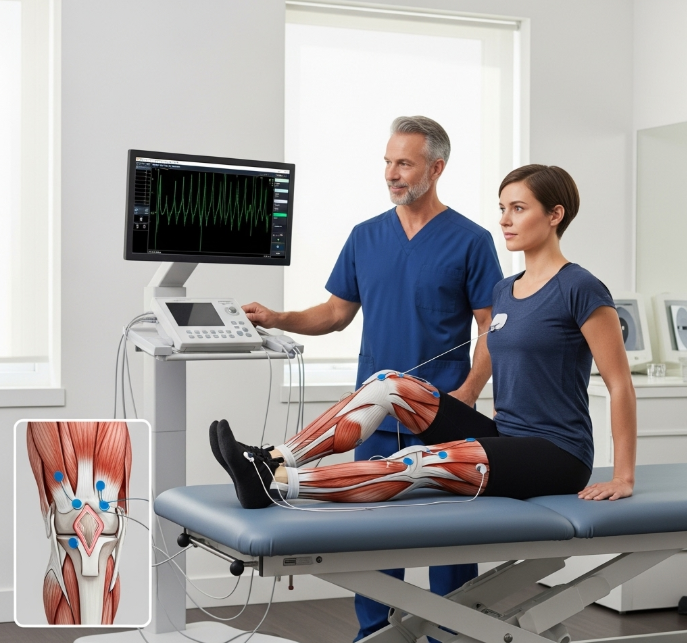Anterior Cruciate Ligament (ACL) surgery is a significant step in your journey back to activity. However, a common
challenge following ACL reconstruction is the loss of quadriceps strength. This weakness can slow down your
recovery, increase the risk of re-injury, and limit your ability to return to your pre-injury activity levels. Fortunately,
advancements in physiotherapy, particularly the use of Electromyography (EMG), offer innovative solutions to
maximize quad strength after ACL surgery. This blog explores how EMG biofeedback, combined with targeted
exercises, can help you achieve a stronger, more functional recovery.
Why Quad Strength Matters After ACL Surgery
The quadriceps muscle group, located on the front of your thigh, is essential for knee stability and function. After
ACL reconstruction, the quads often weaken due to a combination of factors, including pain, swelling, disuse,
and altered neuromuscular control. This weakness can make everyday activities like walking, climbing stairs, or
squatting difficult. Addressing quad weakness is essential for restoring knee function, preventing compensatory
movement patterns, and ensuring long-term joint health. Weakness in the quads can also negatively impact
proprioception and neuromuscular control, potentially leading to secondary injuries if not addressed.
Reduced quad strength can significantly impact your ability to return to sports or other physically demanding
activities. Weakness can lead to instability in the knee joint, increasing the risk of re-injury. Therefore, a
comprehensive rehabilitation program focused on regaining quad strength is essential for a successful recovery.
EMG for ACL Rehab: Assessing Quad Muscle Activation
Electromyography (EMG) is a diagnostic technique that measures the electrical activity produced by your
muscles. In the context of ACL rehabilitation, EMG provides valuable insights into how well your quadriceps
muscles are activating and functioning. It helps physiotherapists assess the extent of muscle weakness, identify
any imbalances between the muscles, and monitor progress throughout the rehabilitation process. EMG can also
be used to assess muscle contraction performance during exercise.
EMG works by placing surface electrodes on the skin over the quadriceps muscles.
These electrodes detect the electrical signals generated when the muscles contract. The signals are then
amplified and displayed on a screen, providing a visual representation of muscle activity. This information allows
physiotherapists to determine whether the muscles are firing correctly, how strongly they are contracting, and
whether there are any compensatory strategies being used. EMG can also help differentiate between different
parts of the quadriceps muscle group, such as the Vastus Medialis Oblique (VMO) and Vastus Lateralis (VL),
allowing for more targeted rehabilitation.
EMG Biofeedback Benefits: Faster ACL Recovery and Stronger Quads
The benefits of EMG biofeedback in ACL rehabilitation are numerous. Firstly, it facilitates faster muscle re-edu-
cation. By providing real-time feedback, EMG biofeedback helps you learn to activate your quadriceps muscles
more effectively, leading to quicker gains in strength and function. Secondly, it improves quad strength gains.
Thirdly, EMG biofeedback leads to better functional outcomes. By improving muscle activation and strength, it
helps you regain the ability to perform everyday activities with greater ease and confidence. Furthermore, EMG
biofeedback can help improve patient motivation and adherence to the rehabilitation program.
Effective ACL Rehab Exercises: Using EMG to Maximize Quad
Strength
Several exercises can be effectively monitored and enhanced with EMG biofeedback during ACL rehabilitation.
Quad sets, which involve contracting the quadriceps muscle while keeping the leg straight, are a foundational
exercise for regaining muscle activation. EMG biofeedback can help you ensure that you are fully engaging the
quadriceps and not relying on other muscles to compensate. Maximum voluntary isometric contraction exercises
(MVIC) at different knee flexion angles can also be monitored using EMG.
Leg extensions, performed on a machine or with resistance bands, can be used to progressively strengthen the
quadriceps. Squats and lunges are functional exercises that challenge the quadriceps in a weight-bearing position.
EMG biofeedback can help you maintain proper alignment and control throughout the movement, reducing the risk
of re-injury. The intensity and form of these exercises can be adjusted using EMG data. Remember to incorporate
proper warm-up and cool-down routines before and after exercises.
Conclusion
Regaining quad strength after ACL surgery is crucial for a successful recovery and a return to your desired
activity level. EMG biofeedback offers a powerful tool to enhance your rehabilitation, providing real-time feedback
to improve muscle activation, strength, and function. By working with a qualified physiotherapist who utilizes EMG
biofeedback, you can personalize your exercise program, track your progress objectively, and achieve optimal
outcomes.
